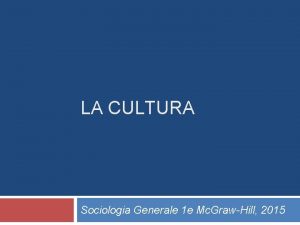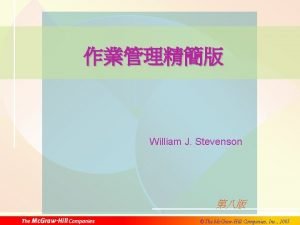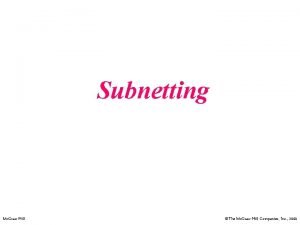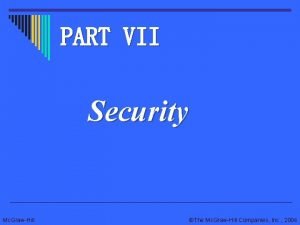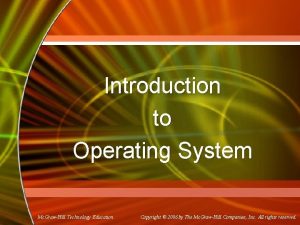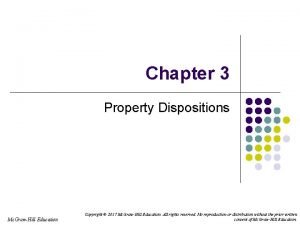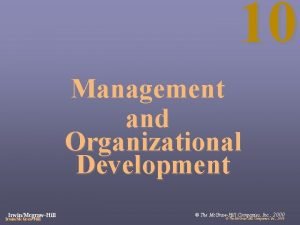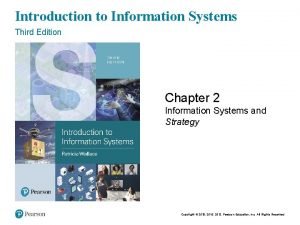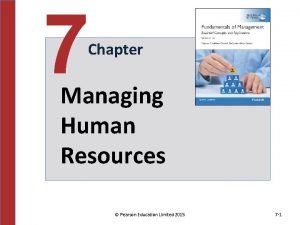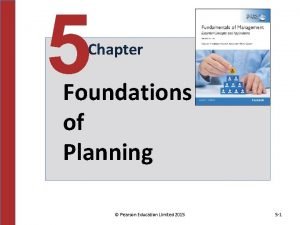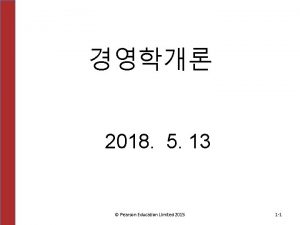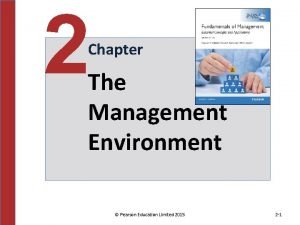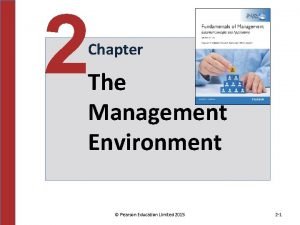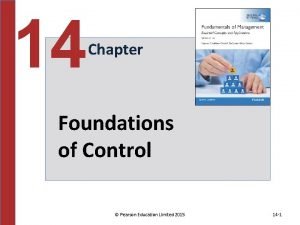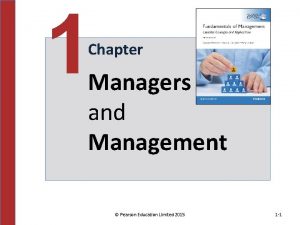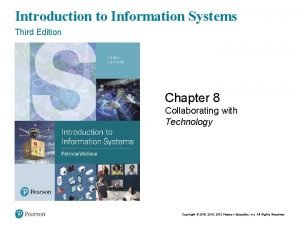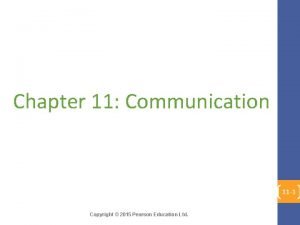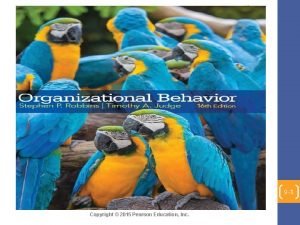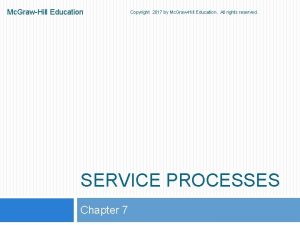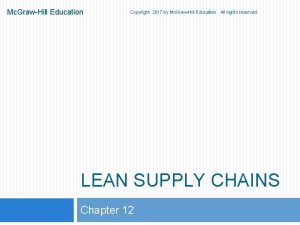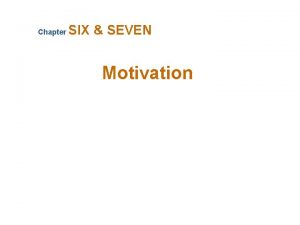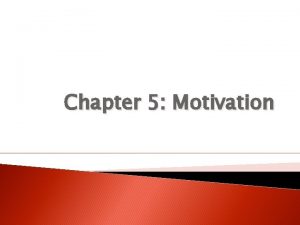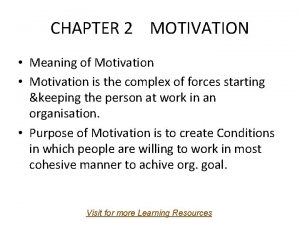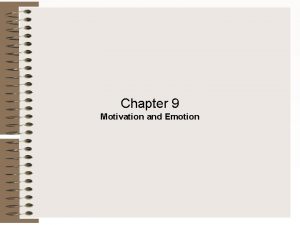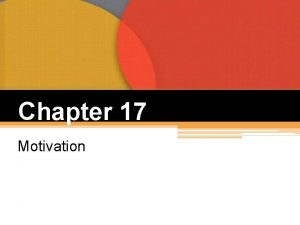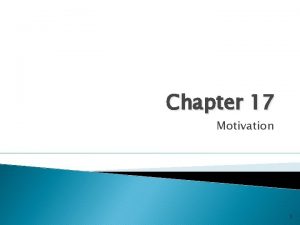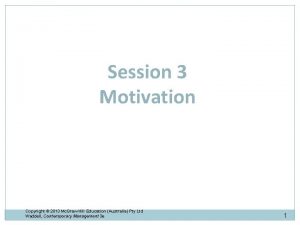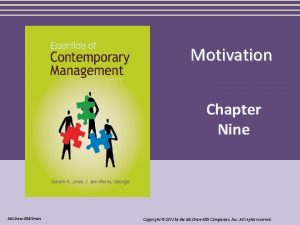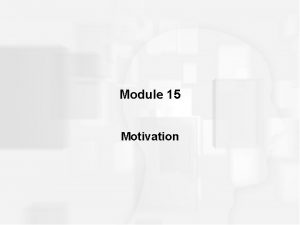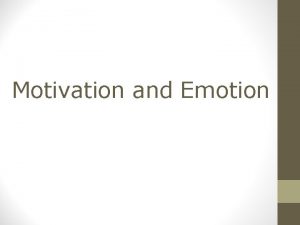Motivation Chapter Nine Copyright 2015 Mc GrawHill Education








































- Slides: 40

Motivation Chapter Nine Copyright © 2015 Mc. Graw-Hill Education. All rights reserved. No reproduction or distribution without the prior written consent of Mc. Graw-Hill Education.

Learning Objectives LO 9 -1 Explain what motivation is and why managers need to be concerned about it LO 9 -2 Describe from the perspectives of expectancy theory and equity theory what managers should do to have a highly motivated workforce LO 9 -3 Explain how goals and needs motivate people and what kinds of goals are especially likely to result in high performance LO 9 -4 Identify the motivation lessons that managers can learn from operant conditioning theory and social learning theory LO 9 -5 Explain why and how managers can use pay as a major motivation tool 9 -2

The Nature of Motivation ªMotivation 9 The psychological forces that determine the direction of a person’s behavior in an organization, a person’s level of effort, and a person’s level of persistence 9 -3

The Nature of Motivation ªDirection 9 possible behaviors the individual could engage in ªEffort 9 how hard the individual will work ªPersistence 9 whether the individual will keep trying or give up 9 -4

The Nature of Motivation ªIntrinsically Motivated Behavior 9 Behavior that is performed for its own sake ªExtrinsically Motivated Behavior 9 Behavior that is performed to acquire material or social rewards or to avoid punishment ªProsocially motivated behavior 9 behavior performed to benefit or help others 9 -5

The Nature of Motivation ªOutcome 9 Anything a person gets from a job or an organization 9 Pay, job security, autonomy, accomplishment ªInput 9 Anything a person contributes to his or her job or organization 9 Time, effort, skills, knowledge, work behaviors 9 -6

The Motivation Equation Figure 9. 1 9 -7

Expectancy Theory ªExpectancy theory 9 The theory that motivation will be high when workers believe that high levels of effort lead to high performance and high performance leads to the attainment of desired outcomes. 9 -8

Question? What is the belief that performance results in the attainment of outcomes? A. Expectancy B. Instrumentality C. Valence D. Motivation 9 -9

Expectancy Theory ª Expectancy 9 the belief that effort (input) will result in a certain level of performance ª Instrumentality 9 the belief that performance results in the attainment of outcomes ª Valence 9 how desirable each of the available outcomes from the job is to a person 9 -10

Expectancy, Instrumentality, and Valence Figure 9. 2 9 -11

Expectancy Theory Figure 9. 3 9 -12

Need Theories ªNeed Theories 9 Theories of motivation that focus on what needs people are trying to satisfy at work and what outcomes will satisfy those needs 9 Basis premise is that people are motivated to obtain outcomes at work to satisfy their needs 9 -13

Maslow’s Hierarchy of Needs 9 -14

Herzberg’s Motivation-Hygiene Theory ªHerzberg’s Motivation-Hygiene Theory 9 A need theory that distinguishes between motivator needs (related to the nature of the work itself) and hygiene needs (related to the physical and psychological context in which the work is performed) and proposes that motivator needs must be met for motivation and job satisfaction to be high. 9 -15

Herzberg’s Motivation-Hygiene Theory ªMotivator needs relate to the nature of the work itself and how challenging it is ªHygiene needs are related to the physical and psychological context in which the work is performed 9 -16

Mc. Clelland’s Needs for Achievement, Affiliation, and Power ªNeed for Achievement 9 A strong desire to perform challenging tasks well and meet personal standards for excellence 9 -17

Mc. Clelland’s Needs for Achievement, Affiliation, and Power ªNeed for Affiliation 9 Extent to which an individual is concerned about establishing and maintaining good interpersonal relations, being liked, and having the people around him get along with each other ªNeed for Power 9 Extent to which an individual desires to control or influence others 9 -18

Equity Theory ªEquity Theory 9 A theory of motivation that focuses on people’s perceptions of the fairness of their work outcomes relative to their work inputs. 9 -19

Equity Theory ªEquity 9 Justice, impartiality, and fairness to which all organizational members are entitled ªInequity 9 Lack of fairness 9 -20

Equity Theory Table 9. 2 9 -21

Equity Theory ªUnderpayment inequity 9 exists when a person perceives that his own outcome–input ratio is less than the ratio of a referent. ªOverpayment inequity 9 exists when a person perceives that his own outcome–input ratio is greater than the ratio of a referent. 9 -22

Goal Setting Theory ªGoal Setting Theory 9 Focuses on identifying the types of goals that are effective in producing high levels of motivation and performance and explaining why goals have these effects 9 -23

Learning Theories ªLearning Theories 9 Theories that focus on increasing employee motivation and performance by linking the outcomes that employees receive to the performance of desired behaviors and the attainment of goals 9 -24

Question? What is a relatively permanent change in person’s knowledge or behavior that results from practice or experience? A. Observation B. Learning C. Anecdotal D. Empirical 9 -25

Learning Theories ªLearning 9 A relatively permanent change in person’s knowledge or behavior that results from practice or experience 9 -26

Operant Conditioning Theory ªOperant Conditioning 9 People learn to perform behaviors that lead to desired consequences and learn not to perform behaviors that lead to undesired consequences. 9 -27

Operant Conditioning Theory ªPositive Reinforcement 9 Giving people outcomes they desire when they perform organizationally functional behaviors ªNegative Reinforcement 9 Eliminating undesired outcomes when people perform organizationally functional behaviors 9 -28

Operant Conditioning Theory ªExtinction 9 Curtailing the performance of a dysfunctional behavior by eliminating whatever is reinforcing them ªPunishment 9 Administering an undesired or negative consequence when dysfunctional behavior occurs 9 -29

Discussion Question Which of the following motivates employees best? A. Positive Reinforcement B. Negative Reinforcement C. Extinction D. Punishment 9 -30

Social Learning Theory ªSocial Learning Theory 9 A theory that takes into account how learning and motivation are influenced by people’s thoughts and beliefs and their observations of other people’s behavior 9 -31

Social Learning Theory ªVicarious Learning 9 Learning that occurs when a learner is motivated to perform a behavior by watching another person perform and be reinforced for doing so 9 Also called Observational Learning 9 -32

Social Learning Theory ªSelf-Reinforcement 9 Any desired or attractive outcome or award that a person can give himself or herself for good performance ªSelf-efficacy 9 A person’s belief about his or her ability to perform a behavior successfully 9 -33

Pay and Motivation ªPay as a Motivator 9 Expectancy: Instrumentality, the association between performance and outcomes, must be high for motivation to be high. 9 Need Theory: pay is used to satisfy many needs. 9 Equity Theory: pay is given in relation to inputs 9 -34

Pay and Motivation ªPay as a Motivator 9 Goal Setting Theory: pay is linked to attainment of goals. 9 Learning Theory: outcomes (pay), is distributed upon performance of functional behaviors. 9 -35

Merit Pay and Performance ªMerit Pay Plan 9 A compensation plan that bases pay on performance 9 -36

Salary Increase or Bonus? ªEmployee Stock Option 9 A financial instrument that entitles the bearer to buy shares of an organization’s stock at a certain price during a certain period of time or under certain conditions. 9 -37

Examples of Merit Pay Plans ªPiece-rate Pay 9 Employee’s pay is based on the number of units that the employee produces ªCommission Pay 9 Employee’s pay is based on a percentage of sales that the employee makes 9 -38

Examples of Merit Pay Plans ªScanlon plan 9 focuses on reduced expenses or cutting costs ªProfit sharing 9 employees receive a share of an organization’s profits 9 -39

Video: SAS ªWhat impact does the multitude of benefits available at SAS have on employee motivation? ªWhat are the advantages of the SAS model? 9 -40
 Grawhill
Grawhill Grawhill
Grawhill 作業管理精簡版13版解答
作業管理精簡版13版解答 Grawhill
Grawhill Mc graw hill
Mc graw hill Mc grawhill
Mc grawhill Grawhill
Grawhill Mc grawhill
Mc grawhill Grawhill
Grawhill Copyright 2015 all rights reserved
Copyright 2015 all rights reserved Copyright © 2015 all rights reserved
Copyright © 2015 all rights reserved Pearson education, inc.
Pearson education, inc. Malaysia education blueprint 2015 to 2025
Malaysia education blueprint 2015 to 2025 Education for all 2000 2015 achievements and challenges
Education for all 2000 2015 achievements and challenges Copyright pearson education inc
Copyright pearson education inc Pearson education limited 2015
Pearson education limited 2015 Pearson education limited 2015
Pearson education limited 2015 2015 pearson education inc
2015 pearson education inc 2015 pearson education inc
2015 pearson education inc Pearson education limited 2015
Pearson education limited 2015 Pearson education limited 2008
Pearson education limited 2008 Pearson education limited 2015
Pearson education limited 2015 Pearson education limited 2015
Pearson education limited 2015 2015 pearson education inc
2015 pearson education inc Pearson education limited 2015
Pearson education limited 2015 Education at a glance 2015
Education at a glance 2015 2015 pearson education inc
2015 pearson education inc 2015 pearson education inc
2015 pearson education inc 2015 pearson education inc
2015 pearson education inc Pearson education limited 2015
Pearson education limited 2015 Pearson education limited 2015
Pearson education limited 2015 Pearson education inc publishing
Pearson education inc publishing 2015 pearson education inc
2015 pearson education inc 2017 pearson education inc
2017 pearson education inc 2017 pearson education inc
2017 pearson education inc Copyright 2010 pearson education inc
Copyright 2010 pearson education inc Copyright 2009 pearson education inc
Copyright 2009 pearson education inc Copyright pearson education inc
Copyright pearson education inc Copyright 2014 pearson education inc
Copyright 2014 pearson education inc Copyright 2010 pearson education inc
Copyright 2010 pearson education inc Copyright 2010 pearson education inc
Copyright 2010 pearson education inc
